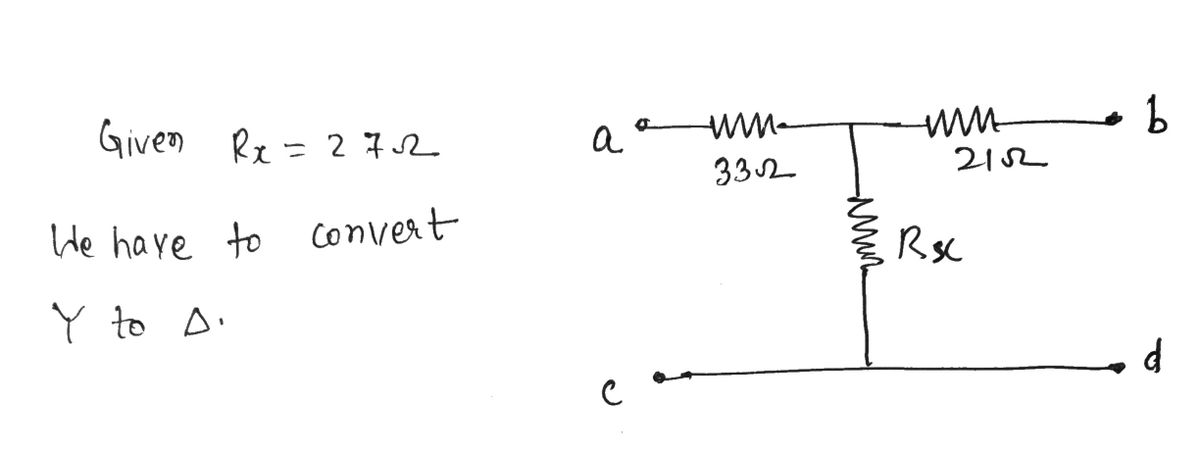Convert the following Y- (or "T-") connected networks to A-connected networks. Convert the given Y- (or “T-") connected network to a A-connected network. In the network, Ry= 27 Q. 332 21 A Rx od The value of the resistor RA in the converted A-connected network is Ω. The value of the resistor Rg in the converted A-connected network is Ω. The value of the resistor Rcin the converted A-connected network is Ω.
Convert the following Y- (or "T-") connected networks to A-connected networks. Convert the given Y- (or “T-") connected network to a A-connected network. In the network, Ry= 27 Q. 332 21 A Rx od The value of the resistor RA in the converted A-connected network is Ω. The value of the resistor Rg in the converted A-connected network is Ω. The value of the resistor Rcin the converted A-connected network is Ω.
Introductory Circuit Analysis (13th Edition)
13th Edition
ISBN:9780133923605
Author:Robert L. Boylestad
Publisher:Robert L. Boylestad
Chapter1: Introduction
Section: Chapter Questions
Problem 1P: Visit your local library (at school or home) and describe the extent to which it provides literature...
Related questions
Question
![## Educational Overview: Converting Y-connected Networks to Δ-connected Networks
### Objective
Convert the following Y- (or "T-") connected networks to Δ-connected networks.
### Task
Convert the given Y- (or "T-") connected network to a Δ-connected network. In the network, \( R_x = 27 \, \Omega \).
### Diagram Explanation
The diagram depicts a Y-connected network composed of three resistors connected at a common point to form a "Y" shape. The resistors have the following values:
- Resistor between point \(a\) and the center: \(33 \, \Omega\)
- Resistor between point \(b\) and the center: \(21 \, \Omega\)
- Resistor \(R_x\) between point \(c\) and the center: \(27 \, \Omega\)
### Calculation Task
Determine the equivalent resistances in the Δ-connected network:
1. **The value of the resistor \( R_A \) in the converted Δ-connected network is:**
\[ \boxed{ \, \Omega} \]
2. **The value of the resistor \( R_B \) in the converted Δ-connected network is:**
\[ \boxed{ \, \Omega} \]
3. **The value of the resistor \( R_C \) in the converted Δ-connected network is:**
\[ \boxed{ \, \Omega} \]
### Conversion Process
For conversion from Y to Δ, the following formulas can be applied:
\[ R_{AB} = \frac{R_a \times R_b + R_b \times R_c + R_c \times R_a}{R_c} \]
\[ R_{AC} = \frac{R_a \times R_b + R_b \times R_c + R_c \times R_a}{R_b} \]
\[ R_{BC} = \frac{R_a \times R_b + R_b \times R_c + R_c \times R_a}{R_a} \]
Where \( R_a, R_b, R_c \) are the Y-connected resistors, and \( R_{AB}, R_{AC}, R_{BC} \) are the equivalent Δ-connected resistors.](/v2/_next/image?url=https%3A%2F%2Fcontent.bartleby.com%2Fqna-images%2Fquestion%2Fc08bab33-dfc3-4475-87c9-eef4dfb69a19%2Ff9d7df5a-f44d-4c23-97e0-9ddb5d53f89b%2F1yqney_processed.png&w=3840&q=75)
Transcribed Image Text:## Educational Overview: Converting Y-connected Networks to Δ-connected Networks
### Objective
Convert the following Y- (or "T-") connected networks to Δ-connected networks.
### Task
Convert the given Y- (or "T-") connected network to a Δ-connected network. In the network, \( R_x = 27 \, \Omega \).
### Diagram Explanation
The diagram depicts a Y-connected network composed of three resistors connected at a common point to form a "Y" shape. The resistors have the following values:
- Resistor between point \(a\) and the center: \(33 \, \Omega\)
- Resistor between point \(b\) and the center: \(21 \, \Omega\)
- Resistor \(R_x\) between point \(c\) and the center: \(27 \, \Omega\)
### Calculation Task
Determine the equivalent resistances in the Δ-connected network:
1. **The value of the resistor \( R_A \) in the converted Δ-connected network is:**
\[ \boxed{ \, \Omega} \]
2. **The value of the resistor \( R_B \) in the converted Δ-connected network is:**
\[ \boxed{ \, \Omega} \]
3. **The value of the resistor \( R_C \) in the converted Δ-connected network is:**
\[ \boxed{ \, \Omega} \]
### Conversion Process
For conversion from Y to Δ, the following formulas can be applied:
\[ R_{AB} = \frac{R_a \times R_b + R_b \times R_c + R_c \times R_a}{R_c} \]
\[ R_{AC} = \frac{R_a \times R_b + R_b \times R_c + R_c \times R_a}{R_b} \]
\[ R_{BC} = \frac{R_a \times R_b + R_b \times R_c + R_c \times R_a}{R_a} \]
Where \( R_a, R_b, R_c \) are the Y-connected resistors, and \( R_{AB}, R_{AC}, R_{BC} \) are the equivalent Δ-connected resistors.
Expert Solution
Step 1

Step by step
Solved in 2 steps with 2 images

Knowledge Booster
Learn more about
Need a deep-dive on the concept behind this application? Look no further. Learn more about this topic, electrical-engineering and related others by exploring similar questions and additional content below.Recommended textbooks for you

Introductory Circuit Analysis (13th Edition)
Electrical Engineering
ISBN:
9780133923605
Author:
Robert L. Boylestad
Publisher:
PEARSON

Delmar's Standard Textbook Of Electricity
Electrical Engineering
ISBN:
9781337900348
Author:
Stephen L. Herman
Publisher:
Cengage Learning

Programmable Logic Controllers
Electrical Engineering
ISBN:
9780073373843
Author:
Frank D. Petruzella
Publisher:
McGraw-Hill Education

Introductory Circuit Analysis (13th Edition)
Electrical Engineering
ISBN:
9780133923605
Author:
Robert L. Boylestad
Publisher:
PEARSON

Delmar's Standard Textbook Of Electricity
Electrical Engineering
ISBN:
9781337900348
Author:
Stephen L. Herman
Publisher:
Cengage Learning

Programmable Logic Controllers
Electrical Engineering
ISBN:
9780073373843
Author:
Frank D. Petruzella
Publisher:
McGraw-Hill Education

Fundamentals of Electric Circuits
Electrical Engineering
ISBN:
9780078028229
Author:
Charles K Alexander, Matthew Sadiku
Publisher:
McGraw-Hill Education

Electric Circuits. (11th Edition)
Electrical Engineering
ISBN:
9780134746968
Author:
James W. Nilsson, Susan Riedel
Publisher:
PEARSON

Engineering Electromagnetics
Electrical Engineering
ISBN:
9780078028151
Author:
Hayt, William H. (william Hart), Jr, BUCK, John A.
Publisher:
Mcgraw-hill Education,